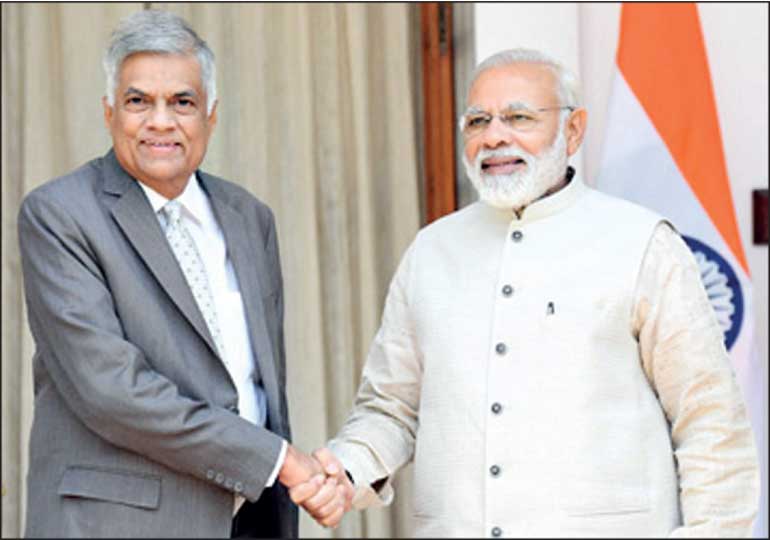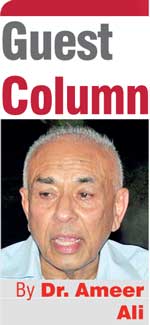Monday Apr 21, 2025
Monday Apr 21, 2025
Saturday, 2 March 2024 00:00 - - {{hitsCtrl.values.hits}}

India needs SL as much as SL needs India
 Never in the history of independent Sri Lanka (SL) had its economic ties with neighbouring India grown so strategic and deep as during Prime Minister Modi’s decade from 2014 to the present. During that decade, SL had seen seven prime ministers and four presidents of whom a couple had been re-elected or appointed to those positions more than once. But what made Indo-Lanka economic connections so strategic and deep is the island’s rapid descent into financial bankruptcy and economic chaos in 2021 because of systemic mismanagement over several decades.
Never in the history of independent Sri Lanka (SL) had its economic ties with neighbouring India grown so strategic and deep as during Prime Minister Modi’s decade from 2014 to the present. During that decade, SL had seen seven prime ministers and four presidents of whom a couple had been re-elected or appointed to those positions more than once. But what made Indo-Lanka economic connections so strategic and deep is the island’s rapid descent into financial bankruptcy and economic chaos in 2021 because of systemic mismanagement over several decades.
Even then and historically, although India’s economy is a giant in comparison to that of tiny SL, in terms of GDP per capita and measures of economic development and welfare the island had an enviable record in comparison to her neighbour. In other words, SL did not have the necessity to beg for economic assistance from India as long as the doors of trade and commerce were kept open.
Partly because of this relative economic strength and partly because of a more enlightened Indian political leadership in addition to the fact that any threat to India’s security never originated from the south but always from north, Indo-Lankan relations until the Modi era could best be described as one of Laissez-faire. However, on occasions when SL approached for security assistance India always responded positively. For example, Sri Lanka could not have eliminated the LTTE and won the civil war had it not been for Delhi’s calculated betrayal of the Tamils.
Having assisted Sri Lanka to win the civil war in 2009 India went back to her policy of non-interference and failed to help the Rajapaksa regime in its post-civil war economic reconstruction efforts. This was a strategic mistake, which allowed rival China to step in and strengthen her foothold in the island. The 99-year leasehold over Hambantota Harbour and few other possessions by China in SL are among its stunning achievements to put into action its One Belt One Road strategy and challenge India’s historic claim over Indian Ocean dominance.
It was K.M. Panikkar, one of India’s foremost historians urged as early as 1945 the first generation of India’s post-colonial rulers that the Indian Ocean must … remain fully Indian and quoted Khaireddin Barbarossa, the advisor to Sultan Suleiman, who said, “He who rules the sea would shortly rule on the land also” (India and the Indian Ocean, George Allen and Unwin Ltd. 1945, p.84). This, when Pakistan enticed SL in 2021 to become another station along the China Pakistan Economic Corridor (CPEC) Indian concerns over China’s growing threat reached a new height. It is in this geopolitical context that SL’s financial bankruptcy and economic collapse began to receive India’s serious attention.
Already, in a trilogy of lectures by PM Modi in 2020, he described India a civilisational nation and Sri Lanka its junior civilisational twin. Later, in an interview with the YouTube channel Swarajya, BJP leader of Tamil Nadu K. Annamalai described India’s largesse to SL as a “civilisational duty”. It was as part of that duty Modi expressed India’s readiness to increase the connectivity between the two civilisational twins when President Ranil Wickremesinghe visited Delhi in 2023. That ideal of connectivity was translated to mean air links, maritime connections, energy and power sharing, trade relations, economic and financial assistance and people to people contacts. In essence, that list leaves out hardly any area except India’s physical occupation of the island to complete that connectivity. Doesn’t this connectivity mean a form of soft colonisation of SL by the senior twin? Indian connectivity has been translated into practical outcomes over the last few years.
PM Modi’s close ally, the Gujarati Adani Group, is the leading Indian investor in Sri Lanka. It is heavily involved in SL’s infrastructure development, which includes renewable energy projects and the West Container Terminal in Colombo Harbour. Recently, Adanis have been given three airports to manage including the international airport at Katunayake, and rumours circulate that a few other state-owned enterprises may be sold to India under the program of economic restructuring insisted by IMF. Already, India promised to build 5,000 homes to Upcountry Indian workers. India has also made several offers to invest in Sri Lanka’s tourism industry, and Minister Diana Gamage in Colombo feels jubilant to reopen the Hindu mythological Ramyana Trails covering Sigiriya, Ashok Garden in Nuwara Eliya, Ravana Ella Falls, Koneswaram Temple, Trincomalee and Divurumpala Temple in Bandarawela. She hopes to attract 5 million Indian tourists annually.
Recently, the Economic and Technical Cooperation Agreement between the two countries was signed, which would increase more Indian presence in SL. Thousands of expert technicians, professionals and experts are leaving the country every year in search of employment abroad. Is India going to fill that gap? Dollar starved SL is now using Indian rupee to settle foreign trade accounts, and India has permitted Sri Lankans to hold $ 10,000 worth of Indian rupees in physical form. Indian rupee is a designated currency now. But could one expect the Indian rupee to take the next logical step to become legal tender in SL to complete the financial connectivity?
What is crucial to note in all these initiatives is the fact that to SL Indian economic and financial connectivity is vital for recovery, but to the regional superpower they are part of its geostrategic moves aimed at regional domination and to resist rivals like China to strengthen its foothold in SL. Is it wrong then to consider the Indian connectivity strategy a pathway to soft colonisation?
It is in this context and amidst rising hopes for a General and/or Presidential election in SL later this year or early next that NPP received an invitation from Delhi and its leader Anura Kumara Dissanayake responded with a visit. On his return that visit turned out to be a hot potato for NPP stalwarts to handle in the face of scurrilous criticisms from its political opponents who accused AKD of a U-turn from JVP’s original stand against Indian expansionism. Digging the past to discredit the present posture of an opponent is a worn-out tactic in electoral politics. True, anti-Indian expansionism was one of the ideological pillars on which the 1970s generation of JVP built its campaign platform. But it is not that generation which is leading NPP after half a century. AKD and his colleagues belong to a new globally linked generation of leaders driven by pragmatic ideals with a disciplined mind and a resolve to reposition Sri Lanka in the global context. They are not prisoners of outdated texts and worshippers of dead heroes.
The poly-crisis in which SL is found trapped today has no parallel in the country’s post-independence history. Therefore, it demands a U-turn from a socio-political paradigm that promoted and thrived on national disunity, unaccountable and reckless economic and financial management and endless perpetuation of injustice. To accomplish that U-turn NPP is advocating a “social revolution” as AKD put it. To realise the objectives of that revolution NPP needs support from both inside and outside the country. India is an outsider, but SL’s closest and resourceful neighbour. Its assistance and connectivity are vital at the moment, but SL has the right as a sovereign nation to draw a line and say thank you and wish good bye when that line is crossed to threaten the country’s sovereignty and independence.
Sri Lanka’s geophysical location in the Indian Ocean is the country’s greatest asset. Therefore, India needs SL as much as SL needs India. In that sense, Indo-Lankan relationship is one between two equals. AKD’s visit to Delhi and his travels to other countries should be seen in that light. Some had even commented sardonically on AKD’s attire in that visit. That reminds me of an incident during the time of Prime Minister SWRD when he attended a dog exhibition in Colombo wearing Western suit. He noticed that his attire was provoking gossips and sarcasm in the crowd. Being a PM with a silver tongue SWRD quipped immediately that he came for a dog exhibition in dog dress, and the murmurs stopped and laughter followed. Let the opponents’ criticisms be fair and constructive rather than scandalous and destructive.
(The writer is attached to Murdoch Business School, Murdoch University, W. Australia.)